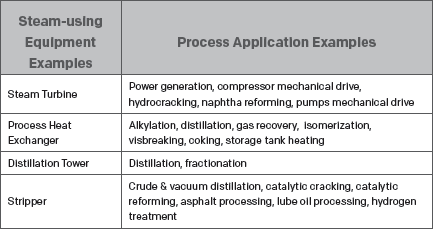Introduction
Based on US Department of Energy figures1, steam systems account for about 30% of the total energy used in industrial applications for product output. These systems can be indispensable in delivering the energy needed for operating an industrial plant; including process heating (e.g., heat exchangers) and steam tracing systems, as well as mechanical drives (e.g., steam turbines).

With the continued need for increased competitiveness, steam system specialists regularly work with plants to identify opportunities to reduce the amount of energy consumed by their steam systems. At the same time, steam system maintenance costs must be optimized and most importantly, health and safety issues and unplanned downtime avoided.
It is clear from Table 1 that steam systems are essential to the refining process. Thus, the integrity and efficiency of steam-using equipment is often critical to refinery productivity. The same goes for steam distribution systems which deliver the steam, and also for steam tracing systems which provide the heat necessary to maintain flow rates in product distribution lines, vessels and reactors. Figure 1 shows a catastrophic failure of refinery and petrochemical complex steam distribution piping reported by the UK Health & Safety Executive (HSE)2. That particular incident resulted in the shutdown of a process unit and associated production losses.
![Failure of a steam distribution line at a combined refinery and petrochemical complex. [2]](https://inspectioneering.com/media/image/inspectioneering_journal/2017/MayJune/Risk-Based-Methodology-for-Industrial-Steam-Systems/Figure-1)
Figure 1. Failure of a steam distribution line at a combined refinery and petrochemical complex.2
Risk-Based Approach
In the process industry, more and more decisions are risk-based, such as maintenance actions, inspection frequencies, and management of change. Risk-based approaches covering hydrocarbon and chemical process equipment are now generally accepted by refinery and process plant operators, regulators, and insurers worldwide. Uptake is based mainly on guidelines developed by the American Petroleum Institute, API RP 5803 and API RP 5814 which employs quantitative evaluations of failure risk:
Risk = PoF x CoF
PoF is the probability of failure, which is time dependent and incorporates generic failure frequencies, local adjustment factors to account for prevailing component damage mechanisms and a management factor to account for quality issues associated with the plant’s management systems. Generic failure frequencies are obtained from industry failure data and represent the average failure frequencies of given equipment types. CoF is the consequence of failure and often expressed as a monetary value and/or square feet or meters of affected area.

















Comments and Discussion
Add a Comment
Please log in or register to participate in comments and discussions.